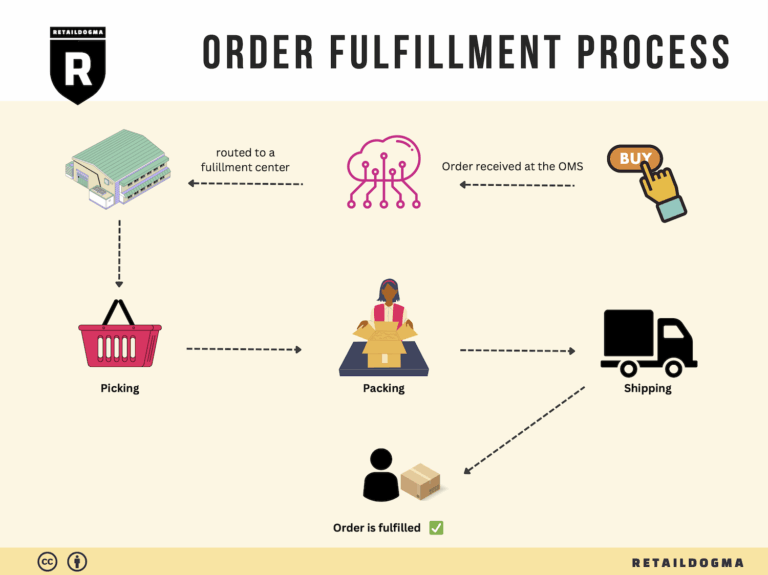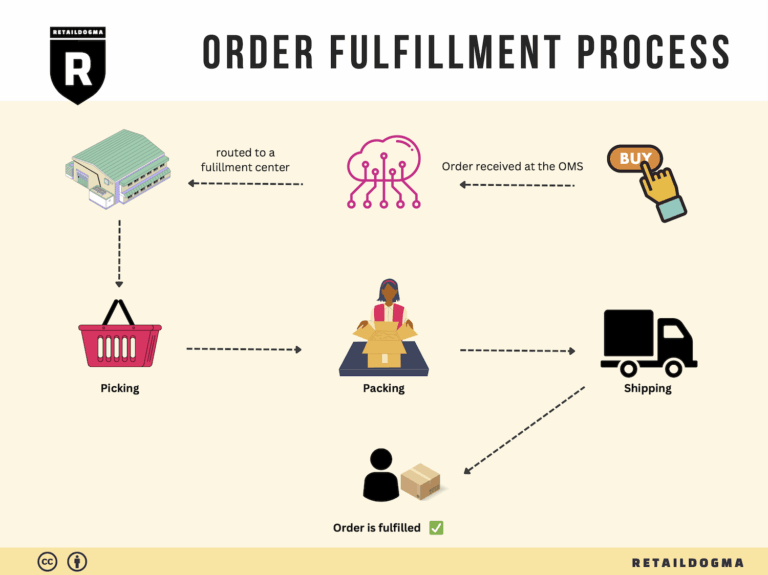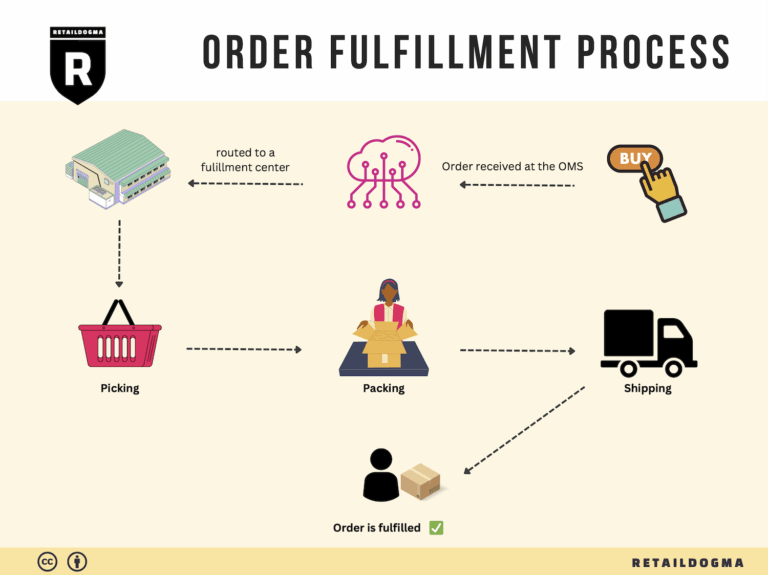How Order Fulfillment Works: A Step-by-Step Guide for Businesses
What is E-commerce Fulfillment? An Introduction for Growing Businesses
Running a growing e-commerce business can be exhilarating, but it often comes with its fair share of challenges. One of the most common pain points faced by online retailers is the overwhelming task of packing and shipping orders. As sales increase, so do the complexities of logistics, often leading to bottlenecks that can hinder customer satisfaction and growth. This is where e-commerce fulfillment steps in.
Understanding Fulfillment
At its core, fulfillment is the process of getting a product from your inventory into the hands of your customers. It encompasses everything from receiving and storing inventory, picking and packing orders, to shipping them out. Effective fulfillment is crucial for maintaining a smooth operation and ensuring that customers receive their orders on time and in good condition.
What This Guide Covers
In this guide, we will explore various aspects of e-commerce fulfillment tailored for growing businesses. We will dive into different fulfillment models, such as third-party logistics (3PL) and Fulfillment by Amazon (FBA), helping you understand the benefits and drawbacks of each. Additionally, we will outline the core services that fulfillment partners typically offer, including inventory management, order processing, and returns handling.
Choosing the right fulfillment partner can be daunting, given the multitude of options available. We will provide practical tips on how to evaluate potential partners based on your specific business needs, including factors like scalability, technology integration, and customer service.
Pricing is another critical area we will cover, as understanding the cost structure of fulfillment services is essential for maintaining profitability. We will break down common pricing models and what you can expect to pay based on your volume and service requirements.
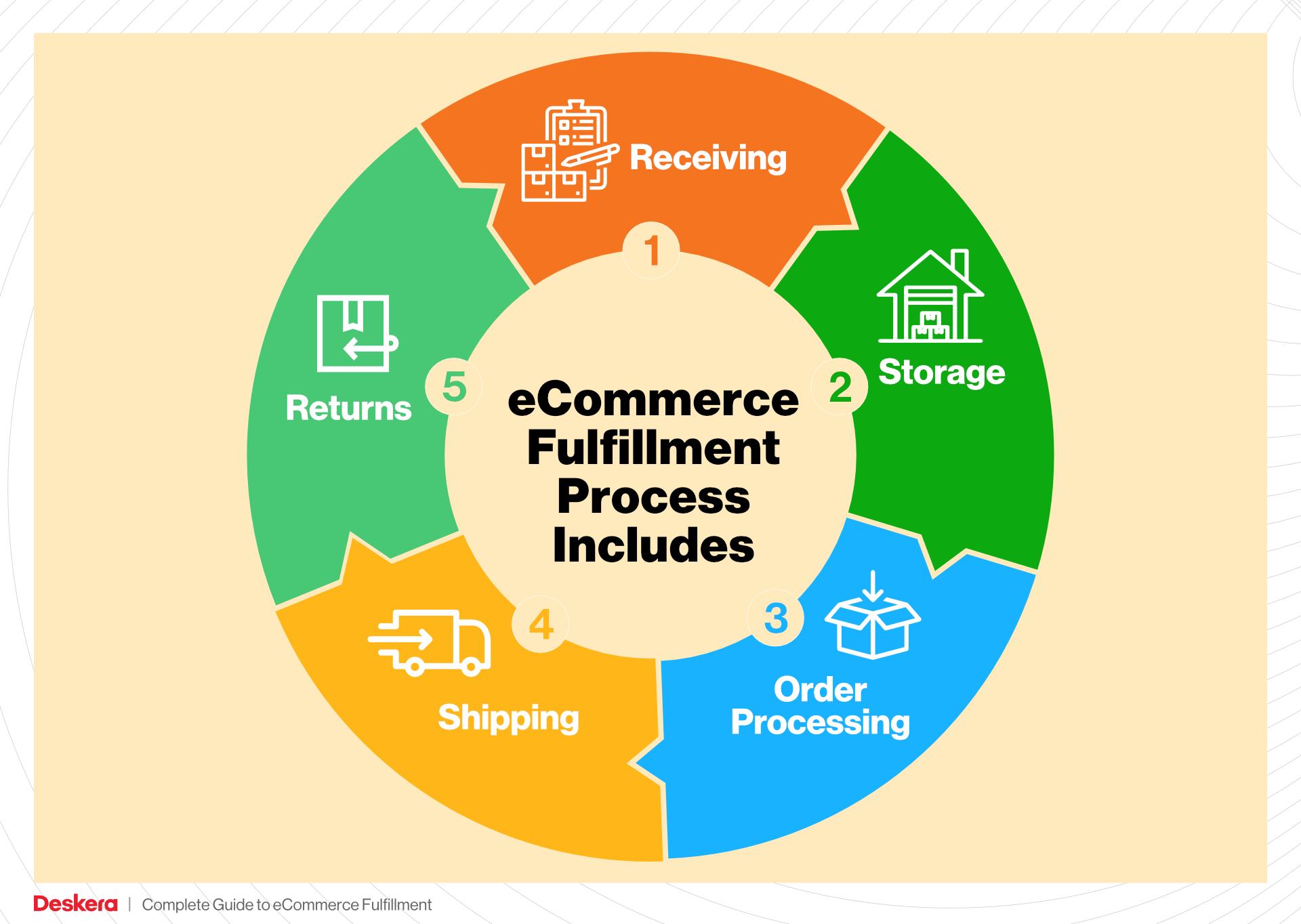
Empowering Your Decisions
The goal of this guide is to empower e-commerce businesses to make informed decisions about their logistics strategies. By understanding the intricacies of fulfillment, you will be better equipped to select the right model and partner that aligns with your growth objectives. As you navigate the complexities of order fulfillment, remember that a well-optimized logistics process can enhance your operational efficiency and significantly improve customer satisfaction, setting the stage for sustainable growth in your e-commerce journey.
What You’ll Learn In This Guide
- What is E-commerce Fulfillment? An Introduction for Growing Businesses
- The Order Fulfillment Process: From ‘Buy’ Button to Customer’s Door
- Comparing Fulfillment Models: In-House vs. 3PL vs. Dropshipping
- A Deep Dive into Amazon FBA: Pros, Cons, and Who It’s For
- Core Services Offered by Fulfillment Centers
- How to Choose a Fulfillment Partner: A 6-Point Checklist
- Understanding Fulfillment Pricing: A Breakdown of Common Fees
- Frequently Asked Questions (FAQs) about Fulfillment
- Conclusion: Is Outsourcing Fulfillment the Right Move for Your Business?
- Important Disclaimer
The Order Fulfillment Process: From ‘Buy’ Button to Customer’s Door
1. Receiving Inventory
The first step in the order fulfillment process is receiving inventory. This stage involves the physical delivery of products to your warehouse or fulfillment center. Upon arrival, each shipment must be inspected for quality and accuracy against the purchase orders. This includes checking for discrepancies in quantity, damages, or any other issues that may arise during transit.
Importance: Properly receiving inventory is crucial as it sets the foundation for all subsequent fulfillment activities. Inaccurate inventory can lead to stockouts or overstocking, both of which can harm customer satisfaction and financial performance.
Key Term: SKU (Stock Keeping Unit) – This unique identifier is essential for tracking products throughout the fulfillment process. Each SKU corresponds to a specific product variant, helping warehouse staff efficiently manage and locate items.
2. Warehouse Storage
Once the inventory is received and verified, the next step is to store it efficiently within the warehouse. This involves categorizing items based on various criteria, such as size, type, or frequency of sales, and placing them in designated storage areas. Effective organization may include using shelving systems, bins, or pallets to maximize space and accessibility.
Importance: Efficient warehouse storage directly impacts the speed and accuracy of order fulfillment. A well-organized warehouse reduces the time taken to retrieve items, which in turn accelerates the overall fulfillment process and enhances customer satisfaction.
Key Term: FIFO (First In, First Out) – This inventory management method ensures that older stock is sold before newer stock, reducing the risk of obsolescence and waste, particularly for perishable goods.
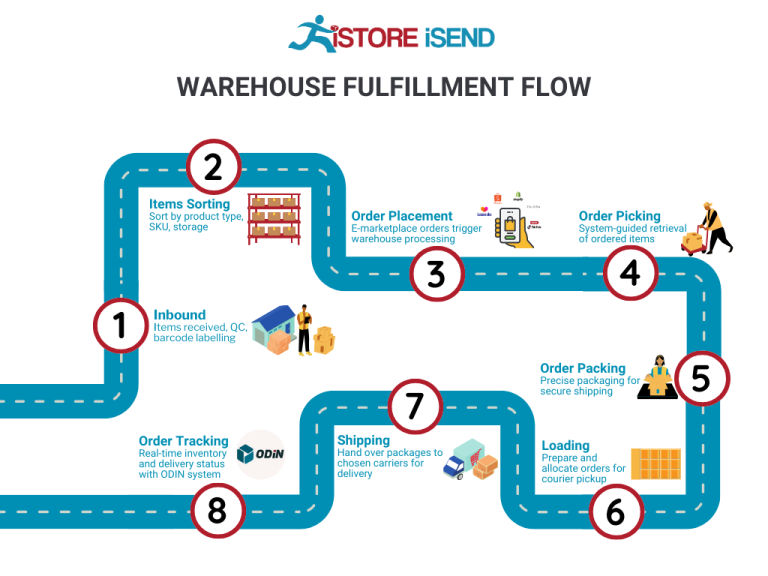
3. Order Picking
Order picking is the process of retrieving items from storage based on customer orders. When a customer clicks the ‘buy’ button, the fulfillment system generates a pick list detailing which items need to be collected. Warehouse staff then use this list to locate and gather the necessary products.
Importance: Efficient order picking is critical to maintaining a high level of accuracy and speed in the fulfillment process. Errors in this stage can lead to incorrect shipments, which can damage customer trust and incur additional costs for returns and reshipments.
Key Term: Pick List – This document or digital display outlines the items to be picked for each order, including quantities and locations within the warehouse. Utilizing technology such as barcode scanners can streamline this process, reducing errors and improving efficiency.
4. Order Packing
After the items are picked, they must be packed for shipment. This involves selecting appropriate packaging materials, such as boxes, bubble wrap, or packing peanuts, to protect the items during transit. The order is then securely sealed and labeled with shipping information, including the destination address and tracking number.
Importance: Proper packing is essential for preventing damage during shipping, which can lead to costly returns and dissatisfied customers. Additionally, well-packed orders help ensure compliance with shipping carrier requirements, facilitating smoother logistics.
Key Term: Packing Slip – This document accompanies the shipment and lists the items included in the package. It provides transparency to the customer and serves as a checklist for the fulfillment team to verify that the correct items are shipped.
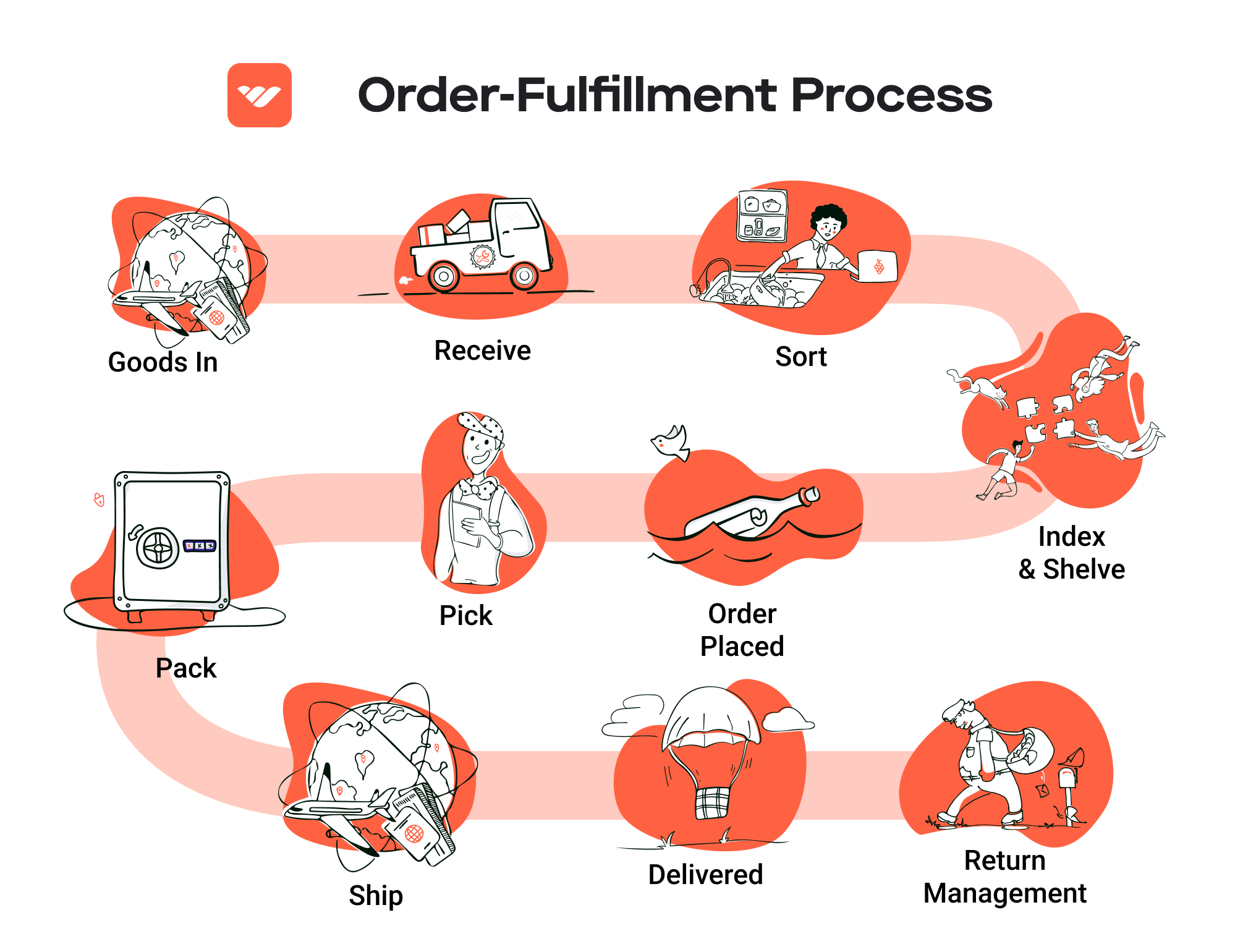
5. Shipping & Delivery
The final step in the fulfillment process is shipping and delivery. Once packed, orders are handed over to shipping carriers for transportation to the customer’s address. Depending on the service level chosen by the customer, this could involve standard shipping, expedited options, or even same-day delivery.
Importance: Timely and reliable shipping is critical for customer satisfaction. In the age of e-commerce, consumers expect fast and efficient delivery. Meeting these expectations can significantly enhance your brand reputation and encourage repeat business.
Key Term: Last Mile Delivery – This term refers to the final step of the delivery process, where the package is transported from a distribution center to the end customer. Efficient last-mile delivery is often the most challenging and costly part of the shipping process, making it a key focus for e-commerce businesses.
By understanding and optimizing each step of the order fulfillment process—from receiving inventory to the customer’s door—you can enhance operational efficiency, improve customer satisfaction, and ultimately drive your e-commerce business’s success.
Comparing Fulfillment Models: In-House vs. 3PL vs. Dropshipping
Comparison of Fulfillment Models
| Model | Who Handles Inventory | Best For (Business Stage) | Key Advantage | Key Disadvantage |
|---|---|---|---|---|
| In-House Fulfillment | The e-commerce business | Established businesses | Full control over inventory and operations | Higher overhead costs and resource demands |
| Third-Party Logistics (3PL) | A third-party logistics provider | Growing businesses | Scalability and reduced operational burden | Less control over inventory and processes |
| Dropshipping | Supplier or manufacturer | Startups and niche businesses | Low upfront investment and minimal risk | Lower profit margins and reliance on suppliers |
In-House Fulfillment
In-house fulfillment refers to the process where an e-commerce business manages its own inventory, order processing, and shipping operations. This model is best suited for established businesses that have the necessary infrastructure and resources to handle these tasks internally. The primary advantage of in-house fulfillment is the level of control it affords the business. Owners can dictate the quality of service, manage inventory precisely, and customize packaging to enhance branding. However, this model comes with significant disadvantages, such as higher overhead costs, including warehousing, staffing, and technology investments. Additionally, managing logistics in-house can strain resources and distract from core business functions, especially for companies aiming to scale rapidly.
Third-Party Logistics (3PL)
Third-party logistics (3PL) is a model where businesses outsource their fulfillment operations to a specialized logistics provider. This approach is ideal for growing businesses that need to scale quickly without the burden of managing logistics themselves. The key advantage of using a 3PL provider is scalability; businesses can easily adjust their logistics needs based on demand fluctuations without incurring the costs associated with maintaining in-house fulfillment capabilities. Furthermore, 3PL providers often have established networks and expertise, which can enhance shipping efficiency and reduce costs. However, the downside is that businesses relinquish some control over their inventory and fulfillment processes. This can lead to challenges in maintaining quality assurance and alignment with customer expectations, as the business may have limited visibility into the logistics operations.
Dropshipping
Dropshipping is a fulfillment model where the retailer does not keep goods in stock. Instead, when a customer places an order, the retailer purchases the item from a third-party supplier, who then ships the product directly to the customer. This model is particularly advantageous for startups and niche businesses, as it requires minimal upfront investment and significantly reduces financial risk. Retailers can offer a wide range of products without the burden of inventory management, allowing them to focus on marketing and sales. However, dropshipping comes with its own set of challenges. The profit margins are generally lower compared to other fulfillment models, as retailers must account for the supplier’s costs. Additionally, businesses relying on dropshipping are often at the mercy of their suppliers regarding stock levels and shipping times, which can lead to customer dissatisfaction if not managed carefully.
By understanding the strengths and weaknesses of each fulfillment model, e-commerce businesses can make informed decisions that align with their operational capabilities, growth ambitions, and customer expectations. Each model offers unique advantages, and the right choice often depends on the specific context of the business and its long-term goals.
A Deep Dive into Amazon FBA: Pros, Cons, and Who It’s For
Understanding Fulfillment by Amazon (FBA)
Fulfillment by Amazon (FBA) is a service provided by Amazon that allows e-commerce sellers to store their products in Amazon’s fulfillment centers. Amazon takes care of storage, packaging, shipping, and customer service on behalf of the sellers. This service is particularly advantageous for small to medium-sized businesses looking to scale their operations without the overhead of managing their own logistics.
When a customer places an order for a product that is fulfilled by Amazon, the process is seamless. Amazon handles everything from picking the product from the warehouse to shipping it directly to the customer. Sellers can also benefit from Amazon’s customer service team, which manages returns and inquiries, allowing them to focus on their core business activities.
How FBA Works
- Product Listing: Sellers create product listings on Amazon and specify that they want to use FBA.
- Inventory Shipment: Sellers send their products to Amazon’s fulfillment centers. Amazon provides guidelines on how to prepare and label products for shipment.
- Storage: The products are stored in Amazon’s warehouses until an order is placed.
- Order Fulfillment: When a customer orders a product, Amazon’s system automatically processes the order, picks the product, packs it, and ships it to the customer.
- Customer Service and Returns: Amazon handles customer inquiries and returns, providing a hassle-free experience for both sellers and customers.
Pros of FBA
1. Prime Eligibility
One of the most significant advantages of using FBA is that products become eligible for Amazon Prime. This means they qualify for free two-day shipping, which can significantly increase sales, as Prime members tend to prefer products with this option.
2. Enhanced Customer Trust
Amazon’s reputation as a reliable retailer extends to FBA sellers. Customers often feel more secure purchasing from sellers that use FBA due to Amazon’s robust return policies and customer service. This trust can lead to higher conversion rates and repeat business.
3. Multi-Channel Fulfillment
FBA isn’t limited to sales on Amazon alone. Sellers can also use FBA to fulfill orders from their own websites or other e-commerce platforms. This flexibility allows businesses to streamline their logistics while reaching customers across various channels.
4. Scalability
FBA allows sellers to scale their businesses without needing to invest in warehousing, staffing, or logistics infrastructure. As demand for products increases, sellers can send more inventory to Amazon’s fulfillment centers without the hassle of managing these operations themselves.
5. Time Savings
By outsourcing logistics to Amazon, sellers can focus on other critical areas of their business, such as marketing, product development, and customer engagement. This time-saving aspect is particularly beneficial for small business owners who wear many hats.
Cons of FBA
1. High Fees
While FBA provides numerous benefits, it also comes with costs. Sellers are charged for storage space, fulfillment services, and additional fees for long-term storage. These fees can eat into profit margins, especially for lower-priced items.
2. Strict Inventory Rules
Amazon has specific guidelines regarding inventory management, including policies on storage limits and the condition of products. Sellers must adhere to these rules to avoid penalties or removal from the FBA program. This can be challenging for businesses with fluctuating inventory levels.
3. Commingling Risks
FBA allows for commingling of inventory, meaning that a seller’s products can be stored alongside other sellers’ products. While this can streamline logistics, it also poses a risk. If a customer receives a defective or damaged item that was commingled, it could reflect poorly on the original seller, leading to negative reviews and customer trust issues.
4. Loss of Control
By using FBA, sellers relinquish a degree of control over their inventory and fulfillment processes. This can be concerning for sellers who prefer to manage their logistics or who have specific requirements for packaging and handling.
5. Complicated Returns
Although Amazon handles customer returns, the process can sometimes be convoluted for sellers. Returned items may not always be returned in their original condition, leading to potential losses.
Who is FBA Best For?
FBA is ideally suited for small to medium-sized e-commerce businesses looking to expand their reach without the complexities of managing logistics. It is particularly beneficial for:
-
New Sellers: Entrepreneurs just starting in e-commerce can leverage Amazon’s infrastructure and customer base to gain traction without significant upfront investment in logistics.
-
Sellers with Seasonal Products: Businesses with fluctuating demand or seasonal items can benefit from FBA’s storage capabilities, allowing them to send inventory to Amazon during peak seasons without the need for permanent warehousing.
-
Brands Seeking Trust: Companies looking to build credibility and trust with consumers can benefit from the enhanced reputation that comes with being part of the Amazon ecosystem.
-
Multi-Channel Sellers: Businesses that sell on multiple platforms can use FBA to simplify their fulfillment processes, allowing for a centralized logistics operation.
-
Time-Constrained Entrepreneurs: Sellers who lack the time or resources to manage fulfillment logistics can focus on growing their businesses while Amazon handles the operational complexities.
In conclusion, while FBA offers numerous advantages that can significantly enhance an e-commerce business’s growth potential, it also presents challenges that sellers must carefully consider. By weighing the pros and cons, businesses can make informed decisions about whether FBA aligns with their operational goals and customer service standards.
Core Services Offered by Fulfillment Centers
Inventory Management & Warehousing
Inventory management and warehousing are foundational services provided by fulfillment centers. This process involves storing products in a secure and organized manner, allowing businesses to maintain optimal inventory levels. Fulfillment centers utilize advanced inventory management systems that track stock levels in real-time, providing visibility into inventory status and helping to prevent stockouts or overstock situations.
Benefits for E-commerce Businesses:
-
Cost Efficiency: By outsourcing warehousing, e-commerce businesses can reduce overhead costs associated with maintaining their own storage facilities. This includes savings on rent, utilities, and staffing.
-
Scalability: Fulfillment centers can easily adjust storage space based on seasonal demand or business growth. This flexibility allows e-commerce businesses to scale up or down without the hassle of managing physical space.
-
Improved Accuracy: Advanced inventory management systems minimize human error in tracking stock levels, ensuring that businesses have accurate data to make informed decisions regarding reordering and product launches.
-
Enhanced Customer Experience: With efficient inventory management, fulfillment centers can ensure that products are readily available for timely order processing and shipping, leading to higher customer satisfaction and retention.
Pick and Pack Services
Pick and pack services refer to the process of selecting items from inventory and preparing them for shipment. Fulfillment centers handle this task with precision, using optimized picking routes and packing techniques to ensure that orders are fulfilled accurately and efficiently.
Benefits for E-commerce Businesses:
-
Time Savings: By outsourcing pick and pack operations, e-commerce businesses can save valuable time. Fulfillment centers are equipped with the necessary tools and expertise to streamline the picking process, allowing businesses to focus on other core activities such as marketing and customer engagement.
-
Order Accuracy: Fulfillment centers implement rigorous quality control measures during the picking and packing process, which helps to reduce errors. This accuracy is crucial for maintaining customer trust and minimizing the costs associated with returns and exchanges.
-
Professional Packaging: Fulfillment centers often provide professional packing services that enhance the presentation of products. This can improve the unboxing experience for customers and help reinforce brand identity.
-
Faster Shipping: With a dedicated team handling pick and pack services, fulfillment centers can expedite the order fulfillment process. This leads to quicker shipping times, which is a critical factor in customer satisfaction in the e-commerce landscape.
Kitting and Assembly
Kitting and assembly services involve the grouping of individual items into ready-to-ship sets or kits. This service is particularly beneficial for businesses that offer bundled products, promotional items, or complex products requiring assembly before shipment.
Benefits for E-commerce Businesses:
-
Increased Sales Opportunities: By offering bundled products or kits, e-commerce businesses can enhance their product offerings, encouraging customers to purchase more items at once. This strategy can increase average order value and improve overall sales.
-
Customization: Kitting allows businesses to create tailored packages that cater to specific customer needs or preferences, enhancing the overall shopping experience and fostering customer loyalty.
-
Efficiency in Shipping: Bundling products into kits can simplify the shipping process. Instead of sending multiple packages to a customer, businesses can send a single package containing all items, reducing shipping costs and improving delivery times.
-
Streamlined Operations: By outsourcing kitting and assembly to fulfillment centers, e-commerce businesses can free up internal resources. This allows them to focus on core business functions while ensuring that complex order fulfillment processes are handled efficiently.
Returns Management (Reverse Logistics)
Returns management, or reverse logistics, is the process of handling product returns, exchanges, and refunds. This service is crucial for e-commerce businesses, as the ease of returns significantly impacts customer satisfaction and loyalty.
Benefits for E-commerce Businesses:
-
Enhanced Customer Trust: A well-managed returns process can increase customer confidence in making purchases. When customers know they can easily return items, they are more likely to complete a transaction.
-
Streamlined Process: Fulfillment centers have established systems for handling returns, making the process faster and more efficient. This includes inspecting returned items, restocking, and processing refunds or exchanges.
-
Data Insights: Returns management services often provide businesses with valuable insights into customer behavior and product performance. Understanding why products are returned can help businesses make informed decisions regarding inventory management, product quality, and marketing strategies.
-
Cost Management: Efficient returns management can help minimize costs associated with processing returns. By analyzing return patterns and trends, businesses can adjust their inventory and purchasing strategies, reducing the likelihood of excess stock and associated losses.
By leveraging these core services offered by fulfillment centers, e-commerce businesses can enhance their operational efficiency, improve customer satisfaction, and ultimately scale their operations effectively. Each service plays a vital role in streamlining processes and creating a seamless experience for both the business and its customers.
How to Choose a Fulfillment Partner: A 6-Point Checklist
Location & Warehouse Network
Choosing a fulfillment partner starts with understanding their location and warehouse network. The geographical placement of warehouses can significantly impact shipping times and costs, which directly influences customer satisfaction.
Why It’s Important:
– Shipping Times: Closer warehouses mean faster delivery to customers.
– Shipping Costs: Reduces costs associated with long-distance shipping.
– Market Reach: A well-distributed network allows you to reach a broader customer base efficiently.
Questions to Ask:
1. Where are your warehouses located, and how many do you operate?
2. What regions do you cover for shipping, and how does that align with our target markets?
3. Do you offer same-day or next-day delivery options in key areas?
Technology & Integrations
In today’s digital landscape, technology plays a crucial role in fulfillment operations. A partner’s technology stack should seamlessly integrate with your existing systems for order processing, inventory management, and customer relationship management.
Why It’s Important:
– Real-Time Data: Access to real-time inventory levels and order tracking enhances operational efficiency.
– Automation: Reduces manual errors and speeds up the fulfillment process.
– Scalability: Advanced technology can adapt as your business grows, providing a future-proof solution.
Questions to Ask:
1. What technology platforms do you use for inventory and order management?
2. Can your system integrate with our existing e-commerce platform (e.g., Shopify, WooCommerce)?
3. Do you offer API access for custom integrations?
Specializations (e.g., Cold Storage, Oversized Items)
Different businesses have unique needs based on their products. Understanding a potential partner’s specializations is essential, especially if you deal with perishable goods or oversized items that require specific handling.
Why It’s Important:
– Expert Handling: Specialized facilities ensure that your products are handled correctly, maintaining quality and compliance.
– Resource Efficiency: A partner that caters to your specific product type can streamline processes, saving time and costs.
Questions to Ask:
1. Do you have specialized facilities for cold storage or hazardous materials?
2. How do you handle oversized or heavy items?
3. What certifications do you hold for specific product handling (e.g., food safety, hazardous materials)?
Scalability & Capacity
As your business grows, your fulfillment needs will evolve. Selecting a partner that can scale alongside you is vital for sustainable growth.
Why It’s Important:
– Flexibility: A scalable partner can adjust to seasonal spikes in demand without compromising service quality.
– Resource Management: Ensures that you won’t face bottlenecks during peak periods.
Questions to Ask:
1. How do you manage capacity during peak seasons (e.g., holidays, sales)?
2. Can you provide a timeline for onboarding additional capacity if needed?
3. What contingency plans do you have in place for unexpected surges in order volume?
Pricing and Contracts
Understanding the cost structure and contract terms is crucial to avoid unexpected expenses and ensure that your partnership remains financially viable.
Why It’s Important:
– Budget Management: Clear pricing helps you maintain control over your operational costs.
– Transparency: Understanding fees associated with various services (e.g., storage, shipping, returns) prevents budget overruns.
Questions to Ask:
1. What are your pricing models (e.g., per order, subscription-based)?
2. Are there additional fees for services such as returns processing or storage?
3. What are the terms of the contract, and are there penalties for early termination?
Customer Support & Reviews
Strong customer support can differentiate a fulfillment partner from its competitors. It’s crucial to assess the quality of support you’ll receive, as well as to review feedback from other clients.
Why It’s Important:
– Issue Resolution: Quick and effective support can mitigate disruptions in your supply chain.
– Reputation: Positive reviews and testimonials indicate a reliable partner.
Questions to Ask:
1. What customer support channels do you offer (e.g., phone, email, chat)?
2. What are your typical response times for support inquiries?
3. Can you provide references or case studies from other clients in our industry?
Final Thoughts
Choosing the right fulfillment partner is a critical decision for any e-commerce business. Each point on this checklist plays a vital role in ensuring that your operations run smoothly, your customers are satisfied, and your business can scale effectively. By asking the right questions and thoroughly evaluating potential partners, you can establish a strong foundation for your fulfillment strategy that supports your growth objectives.
Understanding Fulfillment Pricing: A Breakdown of Common Fees
Initial Setup Fees
Initial setup fees are often the first costs you encounter when engaging with a fulfillment service. These fees cover the necessary administrative work required to onboard your business. Common components of initial setup may include:
- Account Creation: The fulfillment provider will set up your account within their system, which might include integrating your e-commerce platform with their software.
- System Configuration: This involves customizing the fulfillment processes to fit your specific needs, which may include setting up inventory management systems and defining workflows.
- Training: Some providers may offer training sessions for your staff to understand how to use their systems effectively.
Typically, initial setup fees can range from a few hundred to several thousand dollars, depending on the complexity of your operations and the level of customization required. To mitigate these costs, it’s advisable to thoroughly discuss your needs upfront and seek out providers that offer transparent pricing structures.
Receiving Fees
Receiving fees are charged when your inventory arrives at the fulfillment center. This fee covers the labor and resources required to unload, inspect, and stock your products. The calculation of receiving fees can vary based on:
- Volume of Inventory: Some providers charge a flat fee per shipment, while others may charge based on the number of pallets or boxes received.
- Inspection and Quality Checks: If you require additional services like quality control checks, these may incur extra charges.
A typical receiving fee can range from $10 to $50 per pallet, depending on the provider and the complexity of the receiving process. To minimize receiving fees, consider consolidating shipments to reduce the number of deliveries.
Storage Fees (per pallet/bin)
Storage fees are charged for the space your inventory occupies in the fulfillment center. These fees are generally calculated on a monthly basis and can vary depending on:
- Storage Type: Providers may charge differently for pallet storage versus bin storage.
- Duration of Storage: Some fulfillment centers offer tiered pricing based on how long the inventory is stored. Longer storage periods may incur higher fees, especially if the inventory is deemed slow-moving.
On average, storage fees can range from $10 to $30 per pallet per month. To optimize storage costs, keep track of your inventory turnover rates and consider seasonal fluctuations in demand to adjust your inventory levels accordingly.
Pick & Pack Fees (per item/order)
Pick and pack fees are incurred each time an order is processed. This fee covers the labor involved in selecting items from storage and packing them for shipment. Factors influencing pick and pack fees include:
- Number of Items: Many fulfillment centers charge a base fee for the first item and additional fees for each subsequent item in an order.
- Order Complexity: If your orders require special handling or additional packaging materials, these may add to the base fee.
Typically, pick and pack fees range from $1 to $5 per order, with additional costs for extra items. To control these costs, consider optimizing your product offerings and reducing the number of SKUs to streamline the picking process.
Shipping Fees
Shipping fees are one of the most variable costs in fulfillment, as they depend on several factors:
- Shipping Carrier: Different carriers have different rates, which can fluctuate based on service levels (e.g., standard, expedited).
- Destination: Shipping costs can vary significantly depending on whether the package is going locally, nationally, or internationally.
- Package Weight and Dimensions: Heavier or larger packages incur higher shipping costs, so dimensional weight pricing may apply.
Shipping fees can range widely, from $5 for local deliveries to $50 or more for international shipments. To ensure you’re getting the best shipping rates, consider negotiating with fulfillment providers or using software that aggregates multiple carrier rates for comparison.
Tips for Getting an Accurate Quote
-
Provide Detailed Information: When requesting a quote, be clear about your product types, average order size, and expected order volume. This helps providers give you an accurate estimate.
-
Ask About Additional Fees: Inquire about potential hidden fees, such as those for returns, customer service, or special handling requirements.
-
Evaluate Fulfillment Center Locations: The geographical location of the fulfillment center can impact shipping costs and delivery times, so consider how this aligns with your customer base.
-
Request a Trial Period: If possible, negotiate a trial period to evaluate the service without long-term commitments. This can help you understand the true costs involved.
-
Compare Multiple Providers: Don’t settle for the first quote. Comparing multiple fulfillment services can provide insights into industry standards and help you identify the best value for your specific needs.
By understanding these common fulfillment pricing models and following these tips, you can better manage your logistics costs and enhance your e-commerce operations.
Frequently Asked Questions (FAQs) about Fulfillment
1. What is fulfillment in e-commerce?
Fulfillment in e-commerce refers to the entire process of receiving, processing, and delivering orders to customers. This includes inventory management, order picking, packaging, shipping, and handling returns. Effective fulfillment is crucial for customer satisfaction and can significantly impact a business’s reputation and operational efficiency.
2. What’s the difference between fulfillment and shipping?
Fulfillment encompasses a broader range of activities than shipping. While shipping specifically refers to the act of transporting goods from a fulfillment center to the customer, fulfillment includes inventory management, order processing, packaging, and handling returns in addition to shipping.
3. What’s the difference between a warehouse and a fulfillment center?
A warehouse is primarily a storage facility for goods, focusing on inventory management. In contrast, a fulfillment center is designed to streamline the process of fulfilling customer orders, including receiving orders, picking, packing, and shipping products. Fulfillment centers often have more sophisticated technology and processes in place to manage order logistics efficiently.
4. What is a 3PL?
A 3PL, or third-party logistics provider, is a company that offers outsourced logistics services, including fulfillment, warehousing, inventory management, and transportation. Businesses partner with 3PLs to leverage their expertise and infrastructure, allowing them to focus on core activities while ensuring efficient order processing and delivery.
5. How much do fulfillment services cost?
The cost of fulfillment services varies based on several factors, including the volume of orders, storage space required, packaging options, and shipping methods. Typically, fulfillment costs can range from $2 to $5 per order, plus additional fees for storage, handling, and shipping. It’s essential for businesses to evaluate their specific needs and request quotes from multiple providers to find the best fit.
6. What are the benefits of using a fulfillment service?
Using a fulfillment service can provide numerous advantages, including scalability, cost-effectiveness, access to advanced technology, and improved customer satisfaction. By outsourcing fulfillment, businesses can focus on growth and marketing while ensuring that orders are processed efficiently and accurately.
7. How do I choose the right fulfillment partner?
To choose the right fulfillment partner, consider factors such as their location, technology capabilities, pricing structure, customer service reputation, and experience in your industry. It’s also beneficial to look for partners that offer flexible solutions and can scale with your business as it grows.
8. Can I handle fulfillment in-house?
Yes, businesses can handle fulfillment in-house, especially if they have the resources, space, and personnel to manage the logistics effectively. However, as businesses scale, in-house fulfillment can become complex and costly, making it beneficial to consider outsourcing to a fulfillment partner for efficiency and expertise.
9. How does fulfillment impact customer satisfaction?
Fulfillment plays a critical role in customer satisfaction as it directly affects order accuracy, delivery speed, and the overall shopping experience. Efficient and reliable fulfillment processes can lead to repeat purchases, positive reviews, and customer loyalty, while poor fulfillment can result in dissatisfaction and lost sales.
10. What role does technology play in fulfillment?
Technology is integral to modern fulfillment operations. It enables inventory management, order tracking, automated workflows, and data analytics. Utilizing advanced technology solutions can enhance efficiency, reduce errors, and provide valuable insights into customer behavior and inventory trends, ultimately improving the fulfillment process.
Conclusion: Is Outsourcing Fulfillment the Right Move for Your Business?
Evaluating the Benefits of Outsourcing Fulfillment
Outsourcing your fulfillment process can significantly enhance your e-commerce operations, especially as your business scales. One of the foremost advantages is the substantial time savings it offers. By delegating order processing, inventory management, and shipping logistics to a specialized fulfillment partner, you can redirect your focus toward strategic growth areas such as marketing and product development. This shift allows you to leverage your core competencies while ensuring that operational tasks are handled efficiently.
Scalability is another critical benefit of utilizing a fulfillment service. As your sales volume fluctuates—whether due to seasonal trends, marketing campaigns, or unexpected demand spikes—a reliable fulfillment partner can seamlessly adjust to these changes. This flexibility ensures that you are not overwhelmed by increased order volume and can maintain a high level of customer satisfaction through timely deliveries.
Moreover, partnering with an experienced fulfillment provider gives you access to industry expertise and advanced technology. These partners often employ sophisticated inventory management systems, data analytics, and logistics solutions that can enhance your operational efficiency and reduce shipping costs. Their established networks can also facilitate international shipping and returns, allowing you to reach a broader audience without the headaches of managing logistics in-house.
However, selecting the right fulfillment partner is paramount. Not all services are created equal, and the wrong choice can hinder rather than help your growth trajectory. Take the time to evaluate potential partners based on their capabilities, reputation, and alignment with your business goals.
Next Steps: Audit Your Current Process
To determine if outsourcing fulfillment is the right move for your business, conduct a thorough audit of your current shipping and logistics processes. Assess your pain points, such as order accuracy, shipping times, and customer satisfaction. By identifying these areas, you can make informed decisions about whether a fulfillment partner could enhance your operational effectiveness and support your growth strategy. Start this evaluation today to unlock the potential benefits of outsourcing fulfillment for your e-commerce business.
Important Disclaimer
⚠️ Important Disclaimer
The information in this guide is for educational purposes. Fulfillment services, pricing, and platform features change frequently. Always conduct your own due diligence and consult with providers directly before making business decisions.

